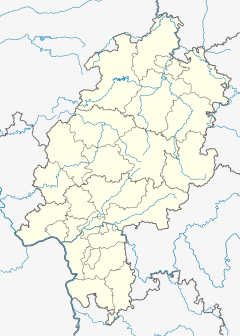
A synagogue, sometimes referred to by the Yiddish term shul and often used interchangeably with the word temple, is a Jewish house of worship. Synagogues have a place for prayer, where Jews attend religious Services or special ceremonies, have rooms for study, social hall(s), administrative and charitable offices, classrooms for religious school and Hebrew school, sometimes Jewish preschools, and often have many places to sit and congregate; display commemorative, historic, or modern artwork throughout; and sometimes have items of some Jewish historical significance or history about the Synagogue itself, on display.

Český Těšín is a town in the Karviná District in the Moravian-Silesian Region of the Czech Republic. It has about 23,000 inhabitants.
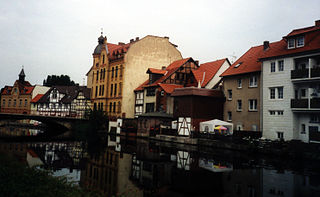
Eschwege, the district seat of the Werra-Meißner-Kreis, is a town in northeastern Hesse, Germany. In 1971, the town hosted the eleventh Hessentag state festival.
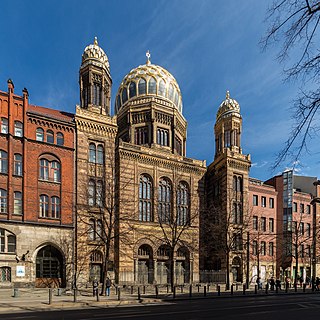
The New Synagogue on Oranienburger Straße in Berlin is a mid-19th century synagogue built as the main place of worship for Berlin's Jewish community, succeeding the Old Synagogue which the community outgrew. Because of its eastern Moorish style and resemblance to the Alhambra, the New Synagogue is an important architectural monument in Germany.

The Oświęcim Synagogue, also called the Auschwitz Synagogue, is the only active synagogue in the town of Oświęcim, Poland. The formal, as well as pre-war, name of the synagogue is Chevre Loymdei Mishnayos. It is now part of the Auschwitz Jewish Center, which includes a Jewish Museum, a cafe in the house of Shimson Kleuger and an education center.
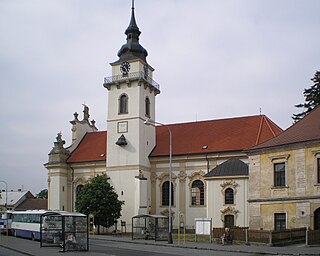
Heřmanův Městec is a town in Chrudim District in the Pardubice Region of the Czech Republic. It has about 4,700 inhabitants. The historic town centre with the castle complex is well preserved and is protected by law as an urban monument zone.
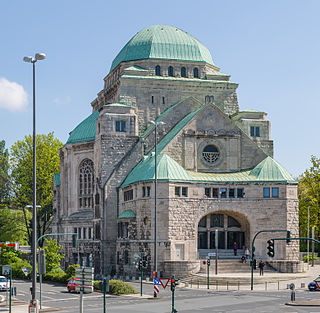
The Old Synagogue in Essen is one of the largest, best preserved and architecturally most impressive testimonies to Jewish culture in pre-war Germany. Built in the centre of the city, the Byzantine style former Synagogue was originally consecrated as the Neue Synagoge in 1913; it now houses an institution dedicated to documenting and promoting the history of the city's former Jewish community.

Alsfeld is a town in the center of Hesse, in Germany.

Gilserberg is a municipality in the Schwalm-Eder district in Hesse, Germany.
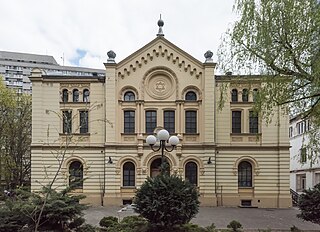
The Nożyk Synagogue is the only surviving prewar Jewish house of prayer in Warsaw, Poland. It was built in 1898-1902 and was restored after World War II. It is still operational and currently houses the Warsaw Jewish Commune, as well as other Jewish organizations.

Zamość Synagogue is a UNESCO-protected Renaissance synagogue built between 1610 and 1618 in Zamość, southeastern Poland. Erected during the times of the Polish–Lithuanian Commonwealth, it functioned as a place of worship for Polish Jews until World War II, when the Nazis turned the interior into a carpenters' workshop. The structure was spared from destruction and in 1992 it became a UNESCO World Heritage Site alongside the Old City of Zamość.

The Old Synagogue was a large structure in Przemyśl, Poland. It was completed in 1594. It was burned down in 1939 when the Germans were retreating from the eastern bank of the San River and the ruins were destroyed by the Nazis in 1941.

The Ramban Synagogue is the second oldest active synagogue in the Old City of Jerusalem, after only the Karaite Synagogue. It dates back in its current location to sometime around 1400. Tradition holds that as an institution, it was founded by the scholar and rabbi Moshe ben Nachman, also known as Nachmanides or Ramban, in 1267, but at a more southerly location on Mount Zion, to help rebuild the local Jewish community, which indeed expanded because of the synagogue's presence. The synagogue was moved to its current location around 1400, where it was destroyed in 1474, rebuilt in 1475, and continued functioning until being closed by the Muslim authorities in the late 16th century. The building was used for industrial and commercial purposes until its destruction in the 1948 Jordanian siege of the Jewish Quarter. After the 1967 Six-Day War, it was rebuilt over the old ruins and reconsecrated as a synagogue.

Rykestrasse Synagogue, Germany's largest synagogue, is located in the Prenzlauer Berg neighbourhood in the Pankow borough of Berlin. Johann Hoeniger built the synagogue in 1903/1904. It was inaugurated on 4 September 1904, in time for the holidays of and around Rosh Hashanah. The synagogue stands off the street alignment and is reached by a thoroughfare in the pertaining front building.

Königsberg's New Synagogue was one of three synagogues in Königsberg in Prussia, East Prussia. The other synagogues were Old Synagogue and Adass Jisroel synagogue. The New Synagogue was destroyed in the aftermath of Kristallnacht in 1938. It was reconstructed and reopened in 2018.

Historic synagogues include synagogues that date back to ancient times and synagogues that represent the earliest Jewish presence in cities around the world. Some synagogues were destroyed and rebuilt several times on the same site. Others were converted into churches and mosques or used for other purposes.

The Hamburg Temple was the first permanent Reform synagogue and the first ever to have a Reform prayer rite. It operated in Hamburg (Germany) from 1818 to 1938. On 18 October 1818 the Temple was inaugurated and later twice moved to new edifices, in 1844 and 1931, respectively.

The Synagoge Zürich Löwenstrasse is the oldest and largest synagogue in the Swiss municipality of Zürich. In 1884 built in Moorish style, the oldest synagogue of Zürich also houses the prayer and school house of Israelitische Cultusgemeinde Zürich (ICZ) which was founded in 1862. ICZ is a unified Jewish community having about 2,500 members, and thus the largest Jewish community in Switzerland, which since 2007 in the Canton of Zürich is recognized as a denomination, i.e. it has the same legal state as the Christian denominations. In the synagogue, the community celebrates the daily Minyan and Shabbat and holiday services. The synagogue is a cultural heritage of national importance in Switzerland.

The synagogue on Fraenkelufer in Berlin's Kreuzberg district was built as an Orthodox Synagogue between 1913 and 1916 according to plans and under the direction of the master builder of the Jewish Community of Berlin, Alexander Beer. The structure was located on Kottbusser Ufer 48–50, today's Fraenkelufer 10-16. On Kristallnacht, the evening of November 9-10th, 1938, the main building of the synagogue was badly damaged. Further destruction in the following years led to the structures ultimate demolition in 1958/1959 after the end of World War II. Today the surviving outbuilding, previously used for the youth service, has been renovated and is home to a Conservative Synagogue. A complete reconstruction of the main synagogue that was destroyed by the National Socialists is being planned for its original location.

The New Synagogue of Graz, is a Jewish synagogue in the city of Graz, Austria. Within the city, it is located on David-Herzog-Place, on the right bank of the Mur River in the Gries neighborhood of Graz. The synagogue serves the Jews of Graz, Styria, Carinthia, and southern parts of Burgenland.

